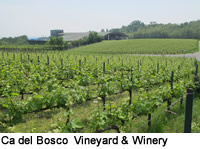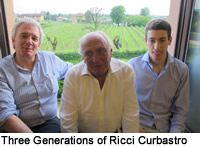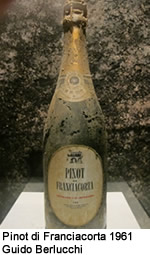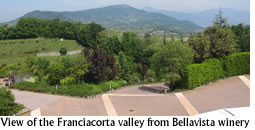 Down the Memory Lane Down the Memory Lane
It was Saturday June 21, 2003. I was at Hotel Marriott in Amsterdam watching TV at night, enroute to Bordeaux to visit Vinexpo the next day. Flipping channels, I came across the Italian RAI Uno where an awards programme was being telecast., I had my eyes and ears glued when I suddenly saw Angelo Gaja walk up to the stage, collect an Award –Oscar del Vino, for Ca’Marcanda as the Best Winery of the Year 2003. I had met Gaja and tasted wines from his latest project in Castagneto Carducci at a special tasting at Vinitaly in 2002. Since I was studying Italian, I decided to continue watching the programme despite the language I didn’t much comprehend.
Winner for the Best Italian Spumante from Italy was Cuvée Annamaria Clementi 1996 from Cá del Bosco from Franciacorta which I knew was considered the ‘champagne’ region of Italy and this was one of the best wineries, certainly the most well-known. What I didn’t realize that day was that Franciacorta Satèn Brut from Ricci Curbastro had also won the Oscar as the Best Value for Money wine of Italy. Franciacorta was on my wish list for a visit since that day.
(These awards given annually by Bibenda are known as Oscars of wine and are given in Rome every year; the programme is televised live by Rai 1 TV channel. For details of all awards for 2003, visit http://www.bibenda.it/oscar_2003.php. Coincidentally, the 2012 awards night is tonight)
I did not get a chance to visit this prestigious sparkling wine making region of Italy until recently when I decided to check it out my way back via Milan, from Portugal where I had gone to judge at Concours Mondial de Bruxelles. The Consorzio had regretted to organize the visit or help me in any way but I was fortunate that most of the producers I directly wrote to- including Ca del Bosco, Bella Vista, Guido Berlucchi, Cavalleri AND Ricci Curbastro, the Oscar winner in 2003 invited me to visit them, instantly.
Franciacorta- The Italian ‘Champagne’ Region
Driving on autostrada A-4 from Milan to Venice, one passes through many industrial districts on the flat lands but at around 90 kms from the airport as you cross the town of Bergamo, the terrain becomes suddenly hilly on your left, there is greenery is all around and one almost smells a wine producing area.
Welcome to Franciacorta, one of the smallest wine producing areas of Italy and yet the Italic Mecca of sparkling wines comparable to Champagne in terms of quality, finesse, elegance and even quality-price ratio. It’s known for its excellent sparkling wines made generally with Chardonnay and Pinot Noir, the signature grapes of Champagne and uses the traditional Champagne method for second fermentation in the bottle. It’s located in the Lombardy region, in the province of Brescia and covers a small area of only about 10*25 kms.
 Demarcated east by the rocky foothills of the Alps, west by the Oglio River, north by the shores of Lake Iseo, and south by the high Po Valley, the territory includes all or in part, nineteen municipalities: Capriolo, Adro, Cazzago San Martino, Cellatica, Coccaglio, Cologne, Corte Franca, Erbusco, Gussago, Iseo, Monticelli Brusati, Ome, Paderno Franciacorta, Paratico, Passirano, Provaglio d'Iseo, Rodengo Saiano, Rovato and Brescia. Demarcated east by the rocky foothills of the Alps, west by the Oglio River, north by the shores of Lake Iseo, and south by the high Po Valley, the territory includes all or in part, nineteen municipalities: Capriolo, Adro, Cazzago San Martino, Cellatica, Coccaglio, Cologne, Corte Franca, Erbusco, Gussago, Iseo, Monticelli Brusati, Ome, Paderno Franciacorta, Paratico, Passirano, Provaglio d'Iseo, Rodengo Saiano, Rovato and Brescia.
Though Franciacorta appeared on a sparkling wine bottle in 1961 and became a DOC in 1967, it has been making still wines for centuries and as Riccardo Ricci Curbastro, owner of Ricci Curbastro told me on my visit- his grandmother used to make sparkling wines for the family as far back as he could remember. He also says that the name Franzacurta first appeared for the first time in the Annals of the Municipality of Brescia in 1277.
It was one of the 11 Italian wines to be granted the DOC status in 1967, limiting the grape varieties to Chardonnay, Pinot Noir, Pinot Bianco and Pinot Grigio and the process to Metodo Classico. The Consorzio per la tutela del Franciacorta was formed in 1990; pushing for self regulation, higher quality, lower yields and reduced use of Pinot Grigio which was totally eliminated in 1995 when the wine was elevated to the DOCG status. In 2003, Franciacorta became the only docg appellation in Italy that did not require it to declare its docg status on the label, like Champagne. Besides ‘Franciacorta’, the style based on residual sugar may be mentioned on the sparkling wine label.
Genesis
The credit for bringing Franciacorta on the Italian and later international map, goes to pioneers like Guido Berlucchi and his then young and ambitious winemaker Franco Ziliani who was an appassionato of Champagne and is the majority shareholder today. Pinot di Franciacorta was released by Berlucchi in 1957 but in 1961 the first batch of 3000 sparkling wine bottles of the same label was released-one can see the historical bottle in their library.
The two top wineries of the day, Ca del Bosco and Bella Vista came on the scene almost a decade later. Maurizio Zanella planted a vineyard and released the bubbly in early seventies after bringing in André Dubois from Moet and Chandon Champagne as his chef de cave. Similarly, Bella Vista was created by Vittorio Moretti who was a real estate developer with a passion for wines, in the late 70s.
 Although there were 11 producers in 1967 when the Doc status was given, including Ricci Curbastro, Fratelli Berlucchi (cousins of Guido), Uberti and Cavalleri (which started bottling only from that point onwards), 80% of the wine produced came from Guido Berlucchi. Although there were 11 producers in 1967 when the Doc status was given, including Ricci Curbastro, Fratelli Berlucchi (cousins of Guido), Uberti and Cavalleri (which started bottling only from that point onwards), 80% of the wine produced came from Guido Berlucchi.
Long aged wines
The special soil conditions described as mineral-rich, granular-sized, calcareous gravel and sandy that cover limestone bedrock as also generally longer time on the lees during the second fermentation in the bottle, make Franciacorta develop a personality and complexity of their own.
Non Vintage wines may be released only 25 months after harvest, of which 18 months must be in contact with the yeast in the bottle, compared to 15 months in the case of Champagne. Vintage or Millesimato may not be sold until at least 37 months after harvest, of which 30 months must be in contact with the yeast- this is similar to Champagne. Also 85% of the base wine must come from the year of the Vintage. The same rule applies to white, Rose or Satèn. Franciacorta Riserva, an excellent example of unique Franciacorta, may be released 67 months after the harvest, 60 months of which must have been spent in the second fermentation in the bottle.
There is a trend to keep this contact longer than the applicable laws to make the wines more rounded, complex and elegant. Also the yields are usually lower than 10 tons/hA as dictated by law.
The DOCG declared vineyards of Franciacorta extend only 2,200 hectares (5,500 acres) and the distribution of permitted grape varieties are 85% Chardonnay, 10% Pinot Nero and 5% Pinot Bianco. Currently around 1800 hA are planted with vines.
Styles of Franciacorta
Based on the Champagne the styles based on sugar dosage are:
Pas Dosé, Non Dosato, Dosage zéro, Pas opéré or Pas nature- these are the driest wines with no sugar, though 0-3 g/l are allowed.
Extra Brut (6g/l), Brut (12 g/l), Sec or Dry (17-32 g/l) and Demi Sec (33-50 g/l) are the other styles- with Brut being the most popular style.
 A unique style claimed to have been developed by Bella Vista and now standardized in the area is known as Satèn (Satin-named after silk not only because the region was known to make silk before China and India took over as the suppliers but also because the bubbles are less aggressive, at a maximum of 5 atm. Compared to the 6.0 for the regular style-making it very smooth and silky on the tongue, feminine and more suitable as a dinner wine). This is also a Blanc de Blancs, made only from white grapes. This may not be a unique wine but perhaps the best example of Franciacorta bubbles. A unique style claimed to have been developed by Bella Vista and now standardized in the area is known as Satèn (Satin-named after silk not only because the region was known to make silk before China and India took over as the suppliers but also because the bubbles are less aggressive, at a maximum of 5 atm. Compared to the 6.0 for the regular style-making it very smooth and silky on the tongue, feminine and more suitable as a dinner wine). This is also a Blanc de Blancs, made only from white grapes. This may not be a unique wine but perhaps the best example of Franciacorta bubbles.
Franciacorta Rosé
Franciacorta spells quality-followed closely by the prices which are certainly not cheap. But it is the Rosé that can give Champagne a run for the money as it offers an excellent quality-price ratio. Although it must have at least 25% Pinot Nero which is grown from different clones for the bubbly, wines like Ricci Curbastro Rose have this percentage as high as 80%, balance being Chardonnay. The beautiful salmon coloured wines are delicious food wines.
Curtefranca doc
While Franciacorta means only sparkling docg wines, the traditional still wines are also being produced, earlier as Terre di Franciacorta but now as Curtefranca Doc. Both Bianco and Rosso are produced, interestingly the whites based on Burgundy style with 50% minimum Chardonnay and the balance being Pinot Bianco or Pinot Nero (Pinot Noir) and the reds – Curtefranca Doc Rosso may use basically Bordeaux grapes-Cabernet Franc, Cabernet Sauvignon, Merlot and Carmenere which seems to be popular with the red wines producers. Small quantities of Nebbiolo and Barbera are also allowed to round off the wines. Interestingly, Cá del Bosco makes a table wine with 100% Carmenere and calls it Carmenero. Perhaps to reserve the use of limited amount of Pinot Noir for the sparkling wines, it is not allowed to be used in Curtefranca Rosso Doc.
IGT Sebino
 Some red and white wines are also produced with the authorized status of IGT Sebino. These are generally, Bianco, Rosso, Novello, Passito and some can also mention the name of the vineyards. Ca del Bosco makes a Maurizio Zanella IGT Sebino with Cabernet Sauvignon, Cabernet Franc and Merlot, named after its founder who sold off a majority share to Santa Margherita almost a decade ago and is still the company President; he is also the current President of the Consorzio. Some red and white wines are also produced with the authorized status of IGT Sebino. These are generally, Bianco, Rosso, Novello, Passito and some can also mention the name of the vineyards. Ca del Bosco makes a Maurizio Zanella IGT Sebino with Cabernet Sauvignon, Cabernet Franc and Merlot, named after its founder who sold off a majority share to Santa Margherita almost a decade ago and is still the company President; he is also the current President of the Consorzio.
Franciacorta as a destination
Franciacorta is an excellent base for holidays that could include, besides winery visits- mountain biking, culinary outings, nature parks. It is also an ideal base for trips to nearby cities like Bergamo (24 km), Brescia (25 km), Cremona (60 km), and Milan (75 km). Lake Iseo is 5 kms away. Lake Garda, Verona and Venice and in fact the whole Veneto wine region can also be traversed by train or car. The Camonica Valley is known for its ski resorts- there are several such attractions. Shopaholics can have a whale of a time finding excellent bargains at the huge ‘Outlet’ in the nearby Rodengo Saiano; such outlets fast becoming a delightful destination for tourists as well as Italians.
Subhash Arora
The visit to wineries- Bella vista, Cá del Bosco, Guido Berlucchi, Cavalleri and Ricci Curbastro will be chronicled in a future edition. Interestingly, they are all interested in the Indian market despite the limitations already known to them. Bella Vista has already tied up with Brindco. Berlucchi used to export to Indage Vintners and is looking for a new importer now-editor |